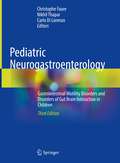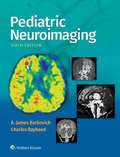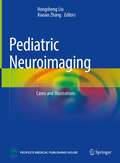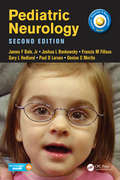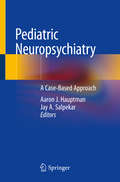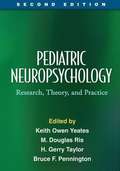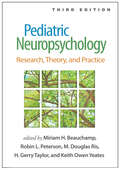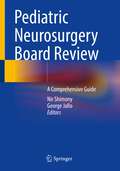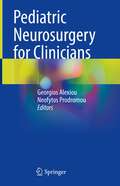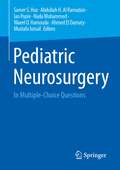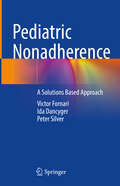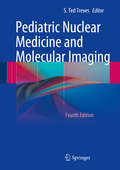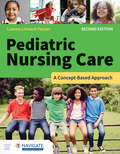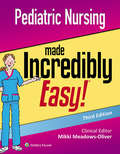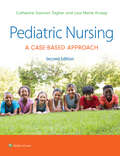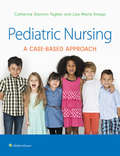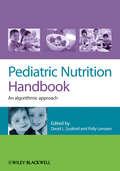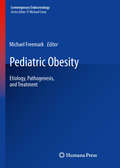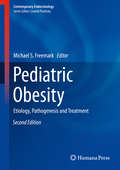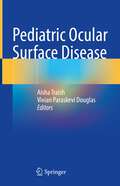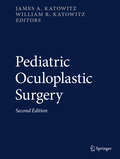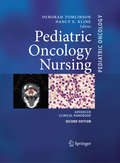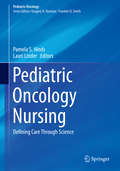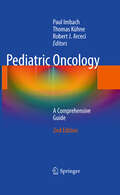- Table View
- List View
Pediatric Neurogastroenterology: Gastrointestinal Motility Disorders and Disorders of Gut Brain Interaction in Children
by Nikhil Thapar Christophe Faure Carlo Di LorenzoThis third edition brings together the latest in research and clinical practice of the expanding field of pediatric neurogastroenterology. In addition to a comprehensive review of the current state of the art, many chapters have been significant revised and updated, covering the latest discoveries of the delicate and detailed mechanisms of the neuroenteric system as well as relationships of the latter with microbiota and metabolites produced by resident intestinal bacteria. The book also covers rapidly-changing techniques to assess clinical problems, along with international diagnostic criteria and recommendations and guidelines for clinical management. The content is supported by ample figures, photographs and selected video segments.Remaining the gold standard text in this up-and-coming field, Pediatric Neurogastroenterology 3e is dedicated to reporting the most accurate and recent knowledge available. Written by international experts in the field, the book is a comprehensive and up-to-date theoretical review and practical guide to pediatric gastrointestinal motility and functional disorders to pediatricians, pediatric gastroenterologists and all professionals involved in the treatment of children with such disorders.
Pediatric Neuroimaging
by A. James Barkovich Charles RaybaudThis newest addition of the comprehensive Pediatric Neuroimaging combines thousands of images with detailed textual descriptions to help you diagnose a wide range of brain, spinal, and head and neck disorders in the pediatric patient. The authors have chosen a clear, concise writing style that encourages you to grasp information quickly. By dealing with a broad range of disorders, from everyday problems to less common ones, and explaining how to recognize and differentiate them, this book offers you the opportunity to provide a concise differential diagnosis on most patients you are likely to encounter in your practice.
Pediatric Neuroimaging: Cases and Illustrations
by Hongsheng Liu Xiaoan ZhangThis book aims to provide readers practical information on clinical diagnosis of pediatric neurological diseases. Topic areas include congenital malformations of the brain and cerebral vessels, brain tumors, intracranial infections, vascular diseases, metabolic encephalopathy, brain damage and destructive diseases. Utilizing a case-based format, the procedure of streamline disease recognition is presented in a clear and concise manner. Each case is supported by representative images, a discussion of the disease, and a description of the most characteristic imaging features of the disorder. Written by radiologists who have been involved pediatric imaging diagnosis for a long time, this case-based book will be a valuable reference for radiologists, paediatricians and neurologists, as well as those who are interested in related field.
Pediatric Neurology: A Color Handbook (Pediatric Diagnosis and Management)
by James Bale Joshua Bonkowsky Francis Filloux Gary Hedlund Paul Larsen Denise MoritaThe fundamental goal of the revised edition of this acclaimed text is to provide comprehensive, practical, and straightforward information about the developing nervous system that is as relevant to those embarking on careers in pediatric neurology as it will be to the experienced practitioner who cares for infants, children, and adolescents. New to this edition are chapters on tumors of the nervous system, autism and related conditions, and practice parameters in child neurology.
Pediatric Neuropsychiatry: A Case-Based Approach
by Aaron J. Hauptman Jay A. SalpekarAdult neuropsychiatry is now a well-established field with numerous reputable references. Practitioners who work with children routinely note how references and practitioners knowledgeable in the equivalent work in the pediatric world are rare. Child psychiatrists and neurologists frequently work with individuals struggling with these conditions and would strongly benefit from such a reference that incorporates medical work-up, psychopharmacological recommendations, family/support recommendations and theoretical pathophysiology. Pediatricians and developmental pediatricians often treat children with behavioral and neuropsychiatric sequelae, but are not well-trained in the neuropsychiatric management of these cases. Neuropsychologists and educational psychologists working with children and adults with pediatric-onset conditions will also find the text helpful to contextualize their cases, better-understand the medical evaluation and management and perhaps adjust recommendations that would supplement their own testing methods. Finally, sub-specialists in adult neurology, psychiatry and neuropsychiatry often find themselves working with these children by default as there are few pediatric subspecialists who are available to accept them into practice. When facing complex neuropsychiatric illness in children, many clinicians are stymied because they may have “never seen a case like that”. This text fills the wide gap that currently exists and helps move this field forward. The approach utilized in adult neuropsychiatry that is both clear and accessible does not yet have an equivalent in the pediatric realm, but there is tremendous interest in its development. Children and adolescents with neuropsychiatric conditions are very common and they and their caregivers often struggle to find professionals well educated in this field. Ultimately, a wide range of clinicians will find this text to be a very helpful resource for diagnosis and management in the spectrum of pediatric neuropsychiatric conditions. The case-based approach is also unique with respect to neuropsychiatric approaches, and the clear cut, reader-friendly approach of such a format would likely be well-received among physicians looking for a resource on this issue.
Pediatric Neuropsychology, Second Edition
by Keith Yeates M. RisThe most comprehensive, authoritative reference of its kind, this acclaimed work examines a wide range of acquired, congenital, and developmental brain disorders and their impact on children\u2019s neuropsychological functioning. Leading experts present state-of-the-art knowledge about how each condition affects the developing brain; the nature and severity of associated cognitive, behavioral, and psychosocial impairments; and effective approaches to clinical evaluation and treatment planning. New to This Edition Reflects significant scientific advances. An additional coeditor, Bruce F. Pennington. Chapters on math, reading, and language disabilities; attention-deficit/hyperactivity disorder; autism; and intellectual disabilities. Medical disorders not covered in prior edition acute disseminated encephalomyelitis and multiple sclerosis; tuberous sclerosis; childhood stroke; and fetal alcohol syndrome. A chapter on evidence-based neuropsychological interventions.
Pediatric Neuropsychology, Third Edition: Research, Theory, and Practice
by Miriam H. Beauchamp, Robin L. Peterson, M. Douglas Ris, H. Gerry Taylor and Keith Owen YeatesRecognized as the definitive reference and text on the relationship between brain health and behavior in children and adolescents, this volume is now in a third edition with 75% new material, including major updates throughout and numerous new chapters. Leading experts provide a neuropsychological perspective on medical, neurological, genetic, and developmental disorders that are frequently seen in clinical practice. The volume examines the impact of each condition on the developing brain; explores associated cognitive, behavioral, and psychosocial impairments; and shows how the science translates into achieving better outcomes for children. New to This Edition *Reflects 12 years of significant research advances and the expanding role of pediatric neuropsychologists; increased attention to evidence-based intervention throughout. *Chapters on additional medical and neurodevelopmental conditions: pediatric stroke, congenital heart disease, type 1 diabetes, and movement disorders. *Section on genetic disorders: fragile X, Williams syndrome, 22q11.2 deletion syndrome, and Down syndrome. *Section on emergent and controversial conditions: nonverbal learning disabilities, dysexecutive syndrome, pediatric acute-onset neuropsychiatric syndrome, and sluggish cognitive tempo.
Pediatric Neurosurgery Board Review: A Comprehensive Guide
by George Jallo Nir ShimonyThis specialized textbook will be dedicated to the various disease topics of pediatric neurosurgery and management strategies. The text will cover the different aspects of the field of pediatric neurosurgery in a unique way by giving state of the art up-to-date synopsis with references to recent publications. More specifically, the whole book is dedicated to a comprehensive discussion of brainstem tumors and other lesions. It will be composed of 20 chapters. The various chapters will start from updates regarding the development of the nervous system and the clinical differences in assessing the infant or a child in comparison to the adult patient. The book then will focus on various pathologies starting with hydrocephalus, pediatric brain and spine tumors, congenital malformation, spasticity, epilepsy, and more. The proposed textbook will be enriched with diagnostic and surgical images, and illustrations that cover all types of pediatric neurosurgery pathologies, with an emphasis on evidence-based data that reflects the controversies and possible solutions. The main structure of each chapter will include a short synopsis of the topic at hand, questions and answers that will inspire the reader for better understanding, learning objectives, and key references for further reading. Written by experts in the field, Pediatric Neurosurgery Board Review serves as a valuable resource for neurosurgery residents and fellows studying for their neurosurgery exams, as well as an educational material for neurosurgery specialists after graduation by discussing pediatric neurosurgery in more convenient way to review and understand key information in this field.
Pediatric Neurosurgery for Clinicians
by Georgios Alexiou Neofytos ProdromouThis book presents a detailed overview of a spectrum of pediatric neurosurgical conditions. It features detailed insight into the techniques available for examining abnormalities, hemorrhages and a variety of tumors. Relevant surgical methodologies are described in relation to a clinical problem or disorder, ensuring that the reader can systematically develop their knowledge of how to perform both routine and more-obscure procedures presently utilized to treat these conditions. Pediatric Neurosurgery for Clinicians is a comprehensive guide detailing methodologies for applying a range of surgical techniques based upon a range of clinical questions. Therefore, it is a critical resource for all practicing and trainee physicians who encounter children with disorders affecting their neurological systems in disciplines within neurosurgery, neurology, radiology, oncology and pathology.
Pediatric Neurosurgery: In Multiple-Choice Questions
by Samer S. Hoz Mustafa Ismail Abdullah H. Al Ramadan Ian Pople Nada Mohammed Waeel O. Hamouda Ahmed El DamatyThis book is the first review book to use the multiple-choice question format in pediatric neurosurgery. More than 500 MCQs are provided in a convenient format that is suitable for self-study.The mission of the book is to help readers understand the content and maintain the knowledge, rather than merely finding answers for complicated questions. The strategy and the format of the questions provide a step-by-step, thorough explanation of each disease from the definition, associated anatomy, pathology, clinical features, radiology to surgical decision-making, and surgical tricks, providing a comprehensive and concise overview. Answers and definitions appear immediately below the questions to facilitate information retention. It is an important asset for residents across neurosurgical disciplines as it includes much of the pediatric neurosurgery knowledge that neurosurgical residents need to prepare for their certification tests. It is also useful for those seeking ways to solidify their knowledge or maintain their current certification. This book is an adjunct to the existing texts and does not intend to be the primary source of information; it rather aims to help readers identify their relevant strengths and weaknesses in the area.
Pediatric Nonadherence: A Solutions Based Approach
by Peter Silver Victor Fornari Ida DancygerNonadherence to pediatric recommendations is a pervasive challenge to the growth, development, and wellbeing of children. Nearly half of all youth and their parents suffer the consequences of misunderstanding, forgetting, ignoring or refusing professional medical advice regarding children. Addressing this widespread dilemma, this unique and comprehensive title explores a variety of different pediatric problems that impact children, adolescents and their families. Clinical case vignettes are provided to highlight particular considerations, and a description of the most up-to-date strategies to solve the dilemma of nonadherence to pediatric care is provided. Indeed, technology is emphasized as an important and innovative means of tracking, interfacing and gathering individual data and facilitating improved pediatric adherence. No one intervention strategy can be applied to solve nonadherence of pediatric patients. Research studies have concluded that successful efforts to enhance adherence rely on a number of important elements. First and foremost is nurturing a trusting relationship between the patient, the family and the clinician, which strengthens the therapeutic alliance. Following that is making sure that the patient and family fully understand the nature of the illness and the recommendations. Effective and clear communication is critical between the health professionals, the patient and the family. When the health professional understands who the patient and the family are on a deeper level, then adherence may be improved. It is imperative that the clinicians take into account the individual patient and families’ cultural, social and community context, as well as their beliefs and support systems. An atmosphere of shared collaboration and mutual respect will improve open communication and the promotion of adherence and positive outcomes. An important thread throughout each chapter is the impact of health care disparities, diversity and equity. The contributors to Pediatric Nonadherence represent a wide range of nationally and internationally recognized experts in their area of pediatric sub-specialization and practice. A major contribution to the clinical literature, this timely title will be of great interest to pediatricians, family practitioners, medical students, residents, fellows, physician assistants, and nurse practitioners.
Pediatric Nuclear Medicine and Molecular Imaging
by S. Ted TrevesThis pioneering book, now in its fourth edition, presents the cutting-edge developments in pediatric nuclear medicine. Thoroughly revised and updated, it retains the fundamentals that anchor the book's distinguished reputation and includes the latest advances in PET/CT, SPECT, hybrid imaging, and molecular imaging. Pediatric Nuclear Medicine and Molecular Imaging, Fourth Edition, is an excellent resource for nuclear medicine physicians, diagnostic radiologists, pediatricians, and residents and fellows. The Fourth Edition features: · 16 new chapters, including PET and PET/CT in Children and Young Adults; Lymphoscintigraphy; Skeletal Scintigraphy; Neuroblastoma; Lymphomas and Lymphoproliferative Disorders; Functional Imaging of Pediatric Musculoskeletal Tumors; Solid Tumors in Childhood; Pediatric Molecular Imaging; Combined PET/MRI in Childhood; Radiation Exposures; Radiation Protection in Pediatric Nuclear Medici≠ and Dose Optimization in Pediatric Nuclear Medicine. · Discussion of the use of image fusion and hybrid imaging in children. · Strategies for communicating potential radiation risk to patients, families and members of the healthcare team. · Methods to optimize pediatric radiopharmaceutical administered doses and improve image quality. S. Ted Treves, MD, is Professor of Radiology at Harvard Medical School, Founder and Former Chief, Division of Nuclear Medicine and Molecular Imaging, Ch ildren's Hospital Boston (1970-2011). In 2013, he received the Society of Nuclear Medicine and Molecular Imaging's Georg Charles de Hevesy Nuclear Pioneer Award for outstanding contributions to the field of Nuclear Medicine.
Pediatric Nursing Care: A Concept-Based Approach
by Luanne Linnard-PalmerPediatric Nursing Care: A Concept-Based Approach, Second Edition provides pre-licensed nursing students the need-to-know information for working as a pediatric nurse in a variety of settings. The concept-based perspective, information on pathologies and diagnoses unique to children, and focus on family-centered care set it apart from other pediatric nursing textbooks. The Second Edition was updated to offer the latest information on family education, current research, safety, and pharmacology. Chapters unique to this text include those focusing on symptoms assessment and management for children, working and communicating in interdisciplinary teams, caring for children across healthcare settings, cultural care models, essential safety models, and pediatric-specific skills. Pediatric Nursing Care: A Concept-Based Approach, Second Edition is a helpful guide and reference for attaining a deeper understanding of the unique aspects of pediatric nursing.
Pediatric Nursing Made Incredibly Easy: Made Incredibly Easy
by Mikki Meadows-OliverCreate a strong foundation in pediatric nursing care — and gain empowering skills and confidence — with the fully updated Pediatric Nursing made Incredibly Easy!®, 3rd Edition. This fully illustrated, enjoyable guide offers easy-to-remember ways to strengthen your understanding and retention of common pediatric conditions at every level of child development. An irreplaceable on-the-job reference for all new nurses, this go-to resource supports class materials, is the ideal study partner for NCLEX®, HESI or CPN exam preparation, and is an excellent refresher for experienced nurses.
Pediatric Nursing: A Case-Based Approach
by Catherine Gannon Tagher Lisa Marie KnappPediatric Nursing: A Case-Based Approach, 2nd Edition, helps students master pediatric nursing concepts and develop the critical thinking and clinical judgment essential to safe pediatric care and health promotion for children of all ages. This extensively updated 2nd Edition details the latest pediatric approaches to COVID-19, child abuse, mental health, and more, accompanied by new learning features that train students to think like nurses and prepare for the Next-Generation NCLEX®. Realistic clinical scenarios challenge students to apply their understanding, reinforcing key content while honing the clinical reasoning, patient advocacy, and patient education skills critical to effective outcomes in any setting.
Pediatric Nursing: A Case-Based Approach (Prepu Series)
by Gannon Tagher Lisa KnappImmerse Yourself in the Role of a Pediatric Nurse Develop the clinical judgment and critical thinking skills needed to excel in pediatric nursing with this innovative, case-based text. Pediatric Nursing: A Case-Based Approach brings the realities of practice to life and helps you master essential information on growth and development, body systems, and pharmacologic therapy as you apply your understanding to fictional scenarios based on real clinical cases throughout the pediatric nursing experience. Accompanying units leverage these patient stories to enrich your understanding of key concepts and reinforce their clinical relevance, giving you unparalleled preparation for the challenges you’ll face in your nursing career. Powerfully written case-based patient scenarios instill a clinically relevant understanding of essential concepts to prepare you for clinicals. Nurse’s Point of View sections in Unit 1 help you recognize the nursing considerations and challenges related to patient-based scenarios. Unfolding Patient Stories, written by the National League for Nursing, foster meaningful reflection on commonly encountered clinical scenarios. Let’s Compare boxes outline the differences between adult and pediatric anatomy and physiology. Growth and Development Check features alert you to age and developmental stage considerations for nursing care. The Pharmacy sections organize medications by problem for convenient reference. Whose Job is it Anyway? features reinforce the individual responsibilities of different members of the healthcare team. Analyze the Evidence boxes compare conflicting research findings to strengthen your clinical judgment capabilities. How Much Does It Hurt? boxes clarify the principles of pediatric pain relevant to specific problems. Hospital Help sections alert you to specific considerations for the hospitalization of pediatric patients. Priority Care Concepts help you confidently assess patients and prioritize care appropriately. Patient Teaching boxes guide you through effective patient and parent education approaches. Patient Safety alerts help you quickly recognize and address potential safety concerns. Interactive learning resources, including Practice & Learn Case Studies and Watch & Learn Videos, reinforce skills and challenge you to apply what you have learned. Learning Objectives and bolded Key Terms help you maximize your study time. Think Critically questions instill the clinical reasoning and analytical skills essential to safe patient-centered practice. Suggested Readings point you to further research for more information and clinical guidance.
Pediatric Nutrition Handbook
by David Suskind Polly LenssenThe last decade has seen an explosion of medical information in regards to the nutrition care and management of children. While nutritional therapies have expanded, the treatment choices have become increasingly complex. This exciting title addresses the extensive amount of information available to practitioners in a concise, accessible fashion via a series of algorithms. It focuses on the normal growing healthy child from birth through adolescence, covering common pediatric diseases and disorders through a series of flows charts which outline step-by-step nutritional processes for pediatric patients. The highly visual format of the book allows the practitioner to make rapid, evidence based choices.Features:Unique algorithm approach to the largest dietetic specialism Highly visual approach allows quick decision making All algorithms and text built on evidence-based research Covers the pediatric phase from birth to adolescence Includes common childhood diseases and disorders
Pediatric Obesity
by Michael FreemarkChildhood obesity and its co-morbidities -- including type 2 diabetes, hypertension, dyslipidemia, sleep apnea, and fatty liver disease -- have seen striking increases in recent years. Despite a wealth of investigation, there is considerable controversy regarding the etiology of childhood obesity and the optimal approaches for prevention and treatment. Pediatric Obesity: Etiology, Pathogenesis, and Treatment addresses the controversy with a range of features that make it a unique resource for those who care for obese children and their families. Written from a perspective that is international in scope, the distinguished authors re-assess the roles of genetic and environmental factors in the pathogenesis of childhood obesity and critically review new studies of the effects of lifestyle, pharmacologic, and surgical interventions. The evidence-based approach of Pediatric Obesity: Etiology, Pathogenesis, and Treatment provides a comprehensive and invaluable guide for all healthcare providers concerned with the evaluation and care of children with nutritional and metabolic disease and with the societal implications of the obesity epidemic.
Pediatric Obesity
by Michael S. FreemarkChildhood obesity and its co-morbidities -- including type 2 diabetes, hypertension, dyslipidemia, sleep apnea, and fatty liver disease -- have seen striking increases in recent years. Despite a wealth of investigation, there is considerable controversy regarding the etiology of childhood obesity and the optimal approaches for prevention and treatment. Pediatric Obesity: Etiology, Pathogenesis, and Treatment addresses the controversy with a range of features that make it a unique resource for those who care for obese children and their families. Written from a perspective that is international in scope, the distinguished authors re-assess the roles of genetic and environmental factors in the pathogenesis of childhood obesity and critically review new studies of the effects of lifestyle, pharmacologic, and surgical interventions. The evidence-based approach of Pediatric Obesity: Etiology, Pathogenesis, and Treatment provides a comprehensive and invaluable guide for all healthcare providers concerned with the evaluation and care of children with nutritional and metabolic disease and with the societal implications of the obesity epidemic.
Pediatric Occupational Therapy Handbook: A Guide to Diagnoses and Evidence-based Interventions
by Patricia Bowyer Susan M. CahillCombining essential assessment guidance with the latest evidence-based intervention strategies, this compact reference helps you quickly locate the information you need to evaluate and manage pediatric disorders. <p><p>Access diagnosis-specific information on epidemiology, precautions, and more, as well as suggested interventions supported by the latest research, all in a convenient, pocket-sized handbook perfect for the busy clinical setting. Information is presented in a consistent format for easy reference and complies with the OT Practice Framework to help you ensure the most effective therapeutic outcomes.
Pediatric Ocular Surface Disease
by Aisha Traish Vivian Paraskevi DouglasOcular surface diseases in children have not always been well understood and the literature in this age group is limited. The consequences of misdiagnosis and delayed diagnosis include visually significant scarring and amblyopia, thus with real impact on their quality of life and ultimate visual potential. Recently, there has been an increase in clinical and research focus on these diseases, contributing to a growing awareness of their importance to pediatric visual health. This book is the first comprehensive volume dedicated to pediatric ocular surface diseases. It provides an up-to-date and highly illustrated discussion of the pathophysiology, symptomatology and diagnostic and therapeutic strategies of these less commonly understood diseases, in a format that is readily absorbed by trainees and seasoned physicians alike. The aim of this book is to provide a practical and detailed understanding of ocular surface disease in the pediatric population, as many of these corneal conditions in children require unique therapeutic approaches and may have subtle presentations. Chapters will address key issues, such as dry eye disease, Steven Johnson Syndrome and neurotrophic keratitis, that can have a profound impact on children’s visual and social development. Pediatric Ocular Surface Disease is a must-have resource for pediatric ophthalmology fellows, cornea fellows, pediatric ophthalmologists, and cornea specialists.
Pediatric Oculoplastic Surgery
by James A. Katowitz William R. KatowitzThis well-illustrated book presents the latest diagnostic concepts and management techniques in the rapidly expanding subspecialty of pediatric oculofacial plastic surgery. Covering all aspects of the field and taking into account numerous surgical innovations and exciting new medical treatment concepts that have emerged since publication of the previous edition in 2002, Pediatric Oculoplastic Surgery, 2nd Edition will prove to be an invaluable resource for both the comprehensive ophthalmologist and the subspecialist with a particular interest in pediatric disorders of the eyelids, orbit, and nasolacrimal system. Topics discussed, in addition to clearly illustrated basic oculoplastic procedures, include surgical innovations ranging from the Sonopet system for safer removal of bone in lacrimal surgery to the development of complex image guidance technology for sinus and orbital surgery. Detailed discussion of syndromic and non-syndromic congenital anomalies explore a variety of surgical techniques and the nuances of applying these approaches in the management of various structural abnormalites. Further important advances include new analytic laboratory techniques, which can illuminate the genetic basis of many pediatric oculoplastic disorders, various medical management advances such as the role of beta blockers in the treatment of facial and orbital hemangiomas, and the development of biologic pathway blockers inhibiting tumor growth which offer real potential for reducing the necessity of surgical intervention.
Pediatric Oncology Nursing
by Nancy E. Kline Deborah TomlinsonThis is the second edition of a comprehensive clinical handbook for nurses in pediatric hematology/oncology that presents in-depth information on pathophysiology, diagnosis, treatment, advanced assessment, and interventions. All chapters have been updated since the first edition, and additional chapters have been included where necessary. The book is divided into five sections: pediatric cancers, hematologic disorders, treatment of childhood cancer, side-effects of treatment and disease, and supportive and palliative care. It is organized in a consistent and accessible format with quick reference guides that will prove invaluable in everyday practice. All of the authors are pediatric experts from the United Kingdom and North America, and their contributions reflect their diverse backgrounds and experiences. This handbook will provide an indispensable tool for those responsible for the clinical nursing care of children with cancer, and assist in meeting the many challenging developments in this specialty.
Pediatric Oncology Nursing: Defining Care Through Science (Pediatric Oncology)
by Pamela S. Hinds Lauri LinderThis book presents the current state of the nursing science in topics relevant to the care of pediatric oncology patients and their families across the treatment trajectory and is framed within a precision health framework. The spectrum of topics covered is wide, including, for example, symptom management, self-care management, exercise and physical activity, family-centered care, palliative care, the role of the nurse in treatment decision making, patient and nurse resiliency, survivorship, and genetic counseling. Throughout, there is a focus on the implications of research for nursing practice, highlighting which elements of the available evidence are ready for translation into practice and which are not. In addition, careful attention is paid to the role that nursing can play in further advancing science through clinical research. The authors are leading experts from across the globe. The book will be of special interest for pediatric oncology nurses, including direct care nurses, research nurses, and nursing leaders, and will also be a stimulating source for researchers and non-oncology nurses.
Pediatric Oncology, 2nd Edition
by Thomas Kühne Robert J. Arceci Paul ImbachThis is the second edition of a well-received compendium of information and guidance on the diagnosis and management of the various oncological diseases that are encountered in children and adolescents. For each disease entity, fundamental facts are provided that will be relevant for a range of professionals - hospital physicians, specialist nurses, psycho-oncologists, physiotherapists, family doctors, and pediatricians. Compared with the first edition, all chapters have been updated and entirely new chapters are included on rare disorders, genetic aspects, and palliative care. Throughout, rapid orientation is ensured by the clear, consistent layout and the concise, lucid style. Pediatric Oncology: A Comprehensive Guide is an excellent, easy-to-use reference that belongs on the shelf of every practitioner who encounters or treats malignancies in the pediatric age group.
